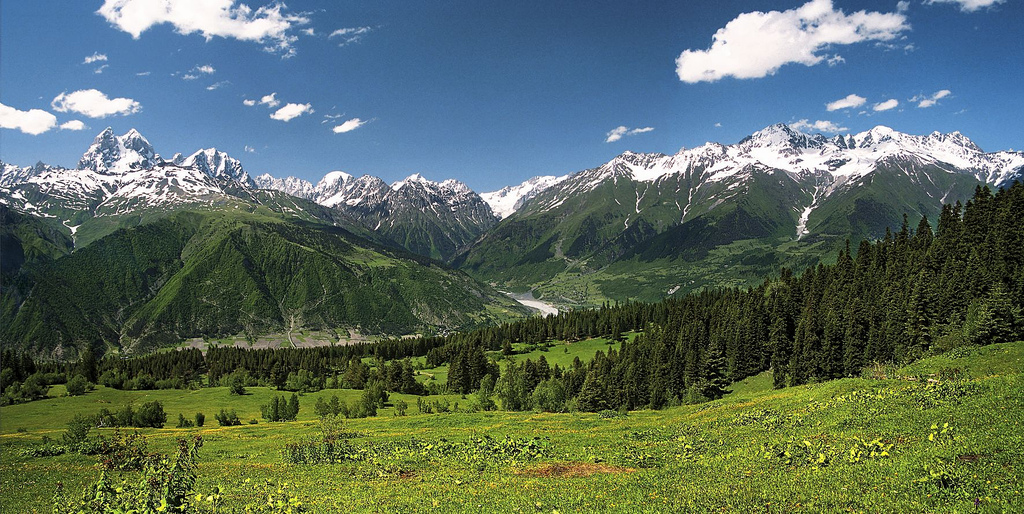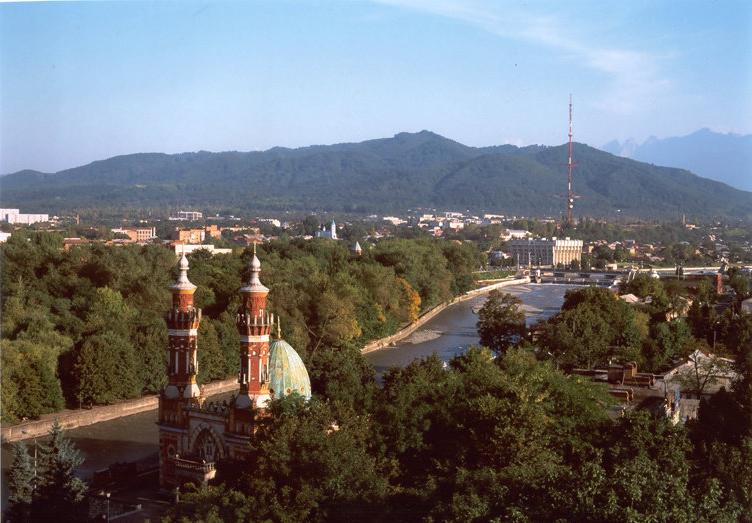|
Devdaraki
Devdaraki ( ka, დევდარაკი) is a valley glacier located on the northeastern slope of Mt. Kazbek. The length of the glacier is and its surface area is . The tongue of the Devdaraki Glacier descends to above sea level. Devdaraki is known for its intense surging properties that have caused significant destruction in the past (particularly from the late 18th to the late 19th centuries). The glacier surges have led to catastrophic mudflows in the Dariali Gorge which have, on several occasions damaged the Georgian Military Highway. A massive collapse of the glacier on August 20, 2014, led to the death of seven people. The Devdaraki Glacier is the source of the River Kabakhi (left tributary of the Terek River). See also *Glaciers of Georgia The glaciers of Georgia are mainly located along the Greater Caucasus Mountain Range. Geography The spatial distribution of contemporary glaciers in the territory of Georgia is stipulated by the peculiarities of atmospher ... [...More Info...] [...Related Items...] OR: [Wikipedia] [Google] [Baidu] |
Kazbek
Mount Kazbek or Mount Kazbegi is a dormant stratovolcano and one of the major mountains of the Caucasus, located on the Russian-Georgian border - in Russia's North Ossetia region and Georgia's Kazbegi District. At 5,034 m (16,515 ft) high, it is one of the highest peaks in Russia and the third-highest peak in Georgia (after Mount Shkhara and Janga). Kazbegi is also the second-highest volcanic summit in the Caucasus, after Mount Elbrus. The summit lies directly to the west of the town of Stepantsminda and is the most prominent geographic feature of the area. The name Kazbeg is disputed; some claims are it is named after a Circassian nobleman who lived on it, other claims are it is named after local nobleman Dimitri Chopikashvili (grand father of the Georgian writer Aleksandre Kazbegi) got the title of "Kazgeb" from Georgian king Erekle II. The word "Kazbek" means a "nobleman" in Kabardian language. The title appeared under Georgian king Rostom in the 17th century. The name ... [...More Info...] [...Related Items...] OR: [Wikipedia] [Google] [Baidu] |
Glaciers Of Georgia
The glaciers of Georgia are mainly located along the Greater Caucasus Mountain Range. Geography The spatial distribution of contemporary glaciers in the territory of Georgia is stipulated by the peculiarities of atmospheric processes, morphological-morphometric conditions of the relief and their interaction. Main centers of glaciation are related to the elevated Greater Caucasus watershed range and Kazbegi massif. Individual centers can be found in the Greater Caucasus branch ranges: Bzipi, Kodori, Samegrelo, Svaneti, Lechkhumi Range, Pirikita, etc. According to the data of 2015 there are 637 glaciers in Georgia with a total area of 355.80 km2. Contemporary glaciers are mainly concentrated in the Enguri, Rioni, Kodori and Tergi River basins, where there are the peaks of 4500 m and higher. 89.32% of the amount and 97.15% of the area of glaciers of Georgia are located in these basins. Contemporary glaciers are unevenly distributed between the different river basins. Here t ... [...More Info...] [...Related Items...] OR: [Wikipedia] [Google] [Baidu] |
Valley Glacier
A valley is an elongated low area often running between hills or mountains, which will typically contain a river or stream running from one end to the other. Most valleys are formed by erosion of the land surface by rivers or streams over a very long period. Some valleys are formed through erosion by glacial ice. These glaciers may remain present in valleys in high mountains or polar areas. At lower latitudes and altitudes, these glacially formed valleys may have been created or enlarged during ice ages but now are ice-free and occupied by streams or rivers. In desert areas, valleys may be entirely dry or carry a watercourse only rarely. In areas of limestone bedrock, dry valleys may also result from drainage now taking place underground rather than at the surface. Rift valleys arise principally from earth movements, rather than erosion. Many different types of valleys are described by geographers, using terms that may be global in use or else applied only locally. ... [...More Info...] [...Related Items...] OR: [Wikipedia] [Google] [Baidu] |
Georgia (country)
Georgia (, ; ) is a transcontinental country at the intersection of Eastern Europe and Western Asia. It is part of the Caucasus region, bounded by the Black Sea to the west, by Russia to the north and northeast, by Turkey to the southwest, by Armenia to the south, and by Azerbaijan to the southeast. The country covers an area of , and has a population of 3.7 million people. Tbilisi is its capital as well as its largest city, home to roughly a third of the Georgian population. During the classical era, several independent kingdoms became established in what is now Georgia, such as Colchis and Iberia. In the early 4th century, ethnic Georgians officially adopted Christianity, which contributed to the spiritual and political unification of the early Georgian states. In the Middle Ages, the unified Kingdom of Georgia emerged and reached its Golden Age during the reign of King David IV and Queen Tamar in the 12th and early 13th centuries. Thereafter, the kingdom decl ... [...More Info...] [...Related Items...] OR: [Wikipedia] [Google] [Baidu] |
Glacier
A glacier (; ) is a persistent body of dense ice that is constantly moving under its own weight. A glacier forms where the accumulation of snow exceeds its Ablation#Glaciology, ablation over many years, often Century, centuries. It acquires distinguishing features, such as Crevasse, crevasses and Serac, seracs, as it slowly flows and deforms under stresses induced by its weight. As it moves, it abrades rock and debris from its substrate to create landforms such as cirques, moraines, or fjords. Although a glacier may flow into a body of water, it forms only on land and is distinct from the much thinner sea ice and lake ice that form on the surface of bodies of water. On Earth, 99% of glacial ice is contained within vast ice sheets (also known as "continental glaciers") in the polar regions, but glaciers may be found in mountain ranges on every continent other than the Australian mainland, including Oceania's high-latitude oceanic island countries such as New Zealand. Between lati ... [...More Info...] [...Related Items...] OR: [Wikipedia] [Google] [Baidu] |
Surge (glacier)
Glacial surges are short-lived events where a glacier can advance substantially, moving at velocities up to 100 times faster than normal. Surging glaciers cluster around a few areas. High concentrations of surging glaciers occur in the Karakoram, Pamir Mountains, Svalbard, the Canadian Arctic islands, Alaska and Iceland, although overall it is estimated that only one percent of all the world's glaciers ever surge. In some glaciers, surges can occur in fairly regular cycles, with 15 to 100 or more surge events per year. In other glaciers, surging remains unpredictable. In some glaciers, however, the period of stagnation and build-up between two surges typically lasts 10 to 200 years and is called the quiescent phase. Dowdeswell, J. A., B. Unwin, A. M. Nuttall and D. J. Wingham. 1999. Velocity structure, flow instability and mass flux on a large Arctic ice cap from satellite radar interferometry. Elsevier Science B.V. During this period the velocities of the glacier are significantly ... [...More Info...] [...Related Items...] OR: [Wikipedia] [Google] [Baidu] |
Daryal Gorge
The Darial Gorge ( ka, დარიალის ხეობა, ''Darialis Kheoba''; russian: Дарьяльское ущелье; os, Арвыком, ''Arvykom''; inh, Даьра Аьле, ''Dära Äle''; Chechen: Теркан чӀаж, ''Terkan ch'azh'') is a river gorge on the border between Russia and Georgia. It is at the east base of Mount Kazbek, south of present-day Vladikavkaz. The gorge was carved by the river Terek, and is approximately long. The steep granite walls of the gorge can be as much as tall in some places. In history The ''Darial'' originates from ''Dar-i Alān'' () meaning "Gate of the Alans" in Persian. The Alans held the lands north of the pass in the first centuries AD. It has been fortified in ancient times by the Romans and Persians; the fortification was variously known as the Iberian Gates or the Caucasian Gates. The pass is mentioned in the Georgian annals under the names of Darialani; Strabo calls it ''Porta Caucasica'' and ''Porta ... [...More Info...] [...Related Items...] OR: [Wikipedia] [Google] [Baidu] |
Georgian Military Highway
The Georgian Military Road or Georgian Military Highway (, 'sakartvelos samkhedro gza'' , os, Арвыкомы фæндаг 'Arvykomy fændag'' is the historic name for a major route through the Caucasus from Georgia to Russia. Alternative routes across the mountains include the Ossetian Military Road and the Transcaucasian Highway. Route The Georgian Military Road runs for between Tbilisi (Georgia) and Vladikavkaz (Russia) and follows the traditional route used by invaders and traders throughout the ages. From Vladikavkaz, the road stretches southwards up the valley of the Terek before passing through the Darial Gorge (which marks the border between Russia and Georgia). It then passes Mount Kazbek and Gergeti Trinity Church before heading south-west through the Georgian region of Khevi to the Jvari Pass, where it reaches its maximum altitude of (). Not long after the pass the road passes the Russia–Georgia Friendship Monument, a large concrete monument built in 1983 ... [...More Info...] [...Related Items...] OR: [Wikipedia] [Google] [Baidu] |
Terek River
The Terek (; , Tiyrk; , Tərč; , ; , ; , ''Terk''; , ; , ) is a major river in the Northern Caucasus. It originates in the Mtskheta-Mtianeti region of Georgia (country), Georgia and flows through North Caucasus region of Russia into the Caspian Sea. It rises near the juncture of Caucasus Mountains, the Greater Caucasus Mountain Range and the Khokh Range, to the southwest of Mount Kazbek, winding north in a white torrent between the town of Stepantsminda and the village of Gergeti toward the Russian region North Ossetia and the city of Vladikavkaz. It turns east to flow through Chechnya and Dagestan before Water divide, dividing into two branches which empty into the Caspian Sea. Below the city of Kizlyar it forms a swampy river delta around wide. The river is a key natural asset in the region, providing irrigation and hydroelectric power in its upper reaches. The main cities on the Terek include Vladikavkaz, Mozdok, and Kizlyar. Several minor Hydroelectricity, hydroelectric ... [...More Info...] [...Related Items...] OR: [Wikipedia] [Google] [Baidu] |



